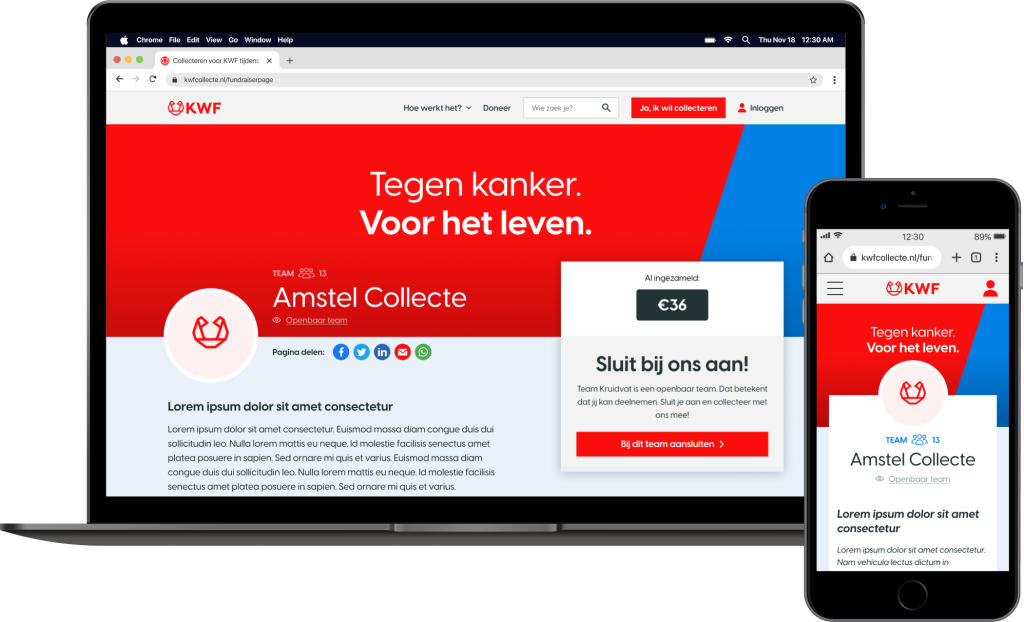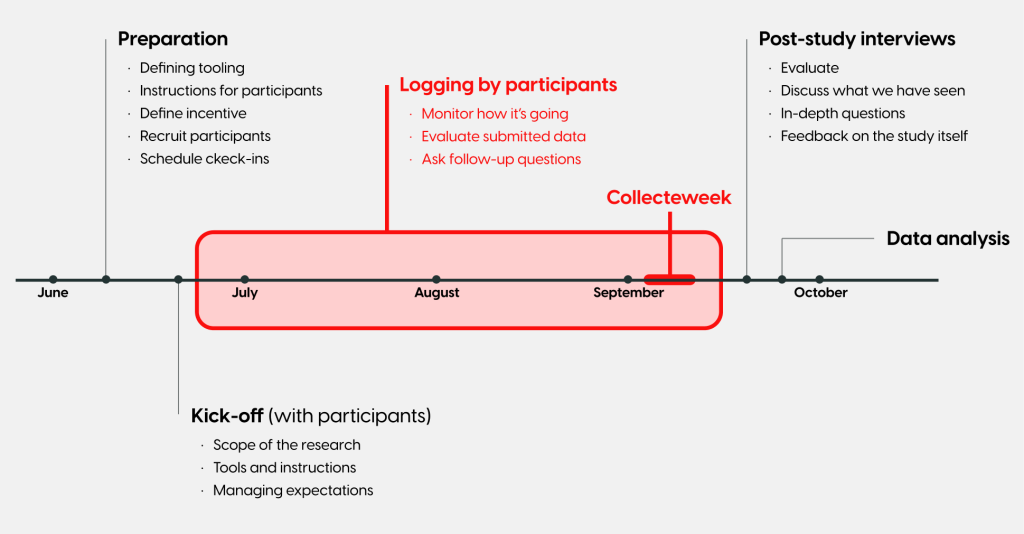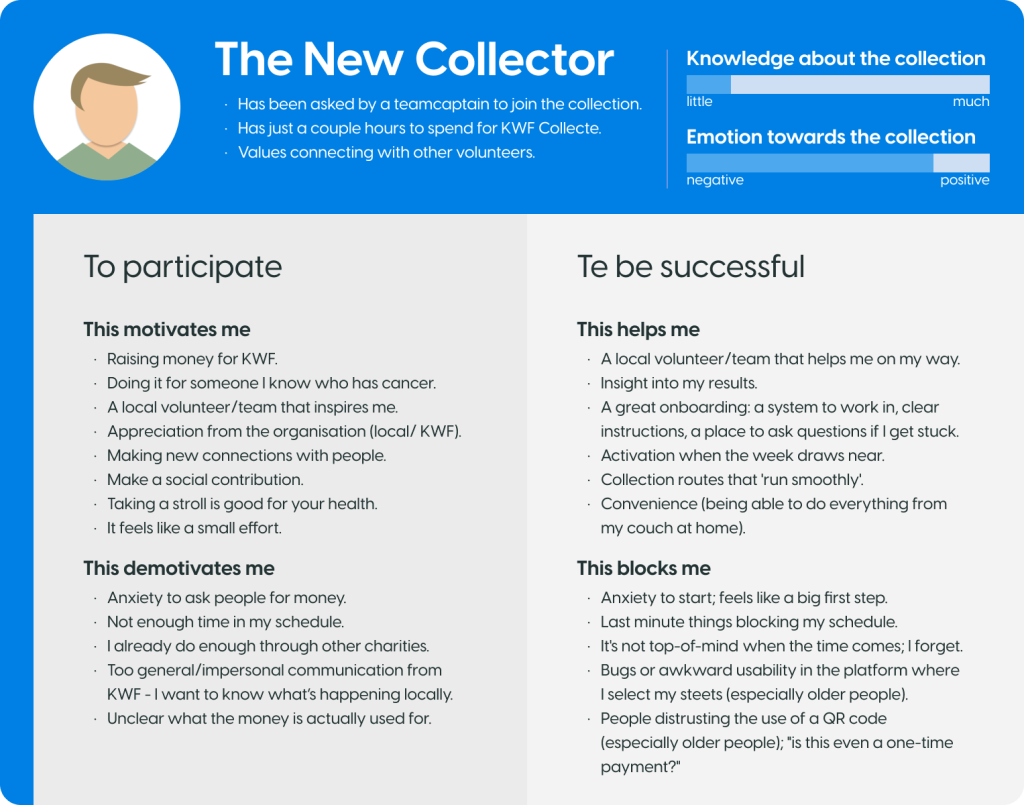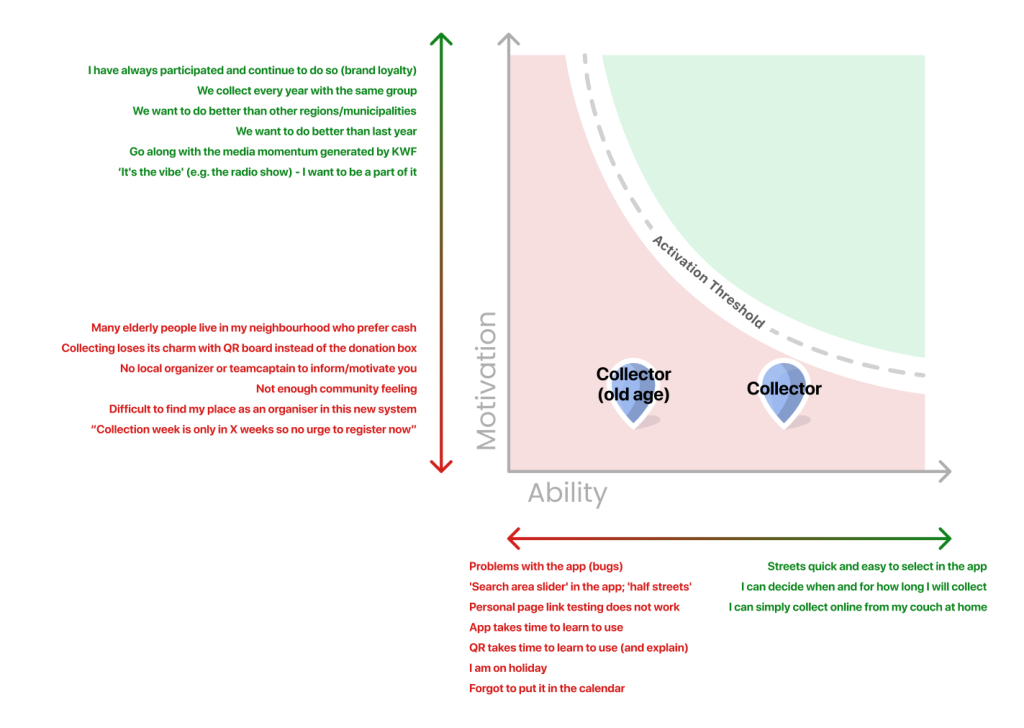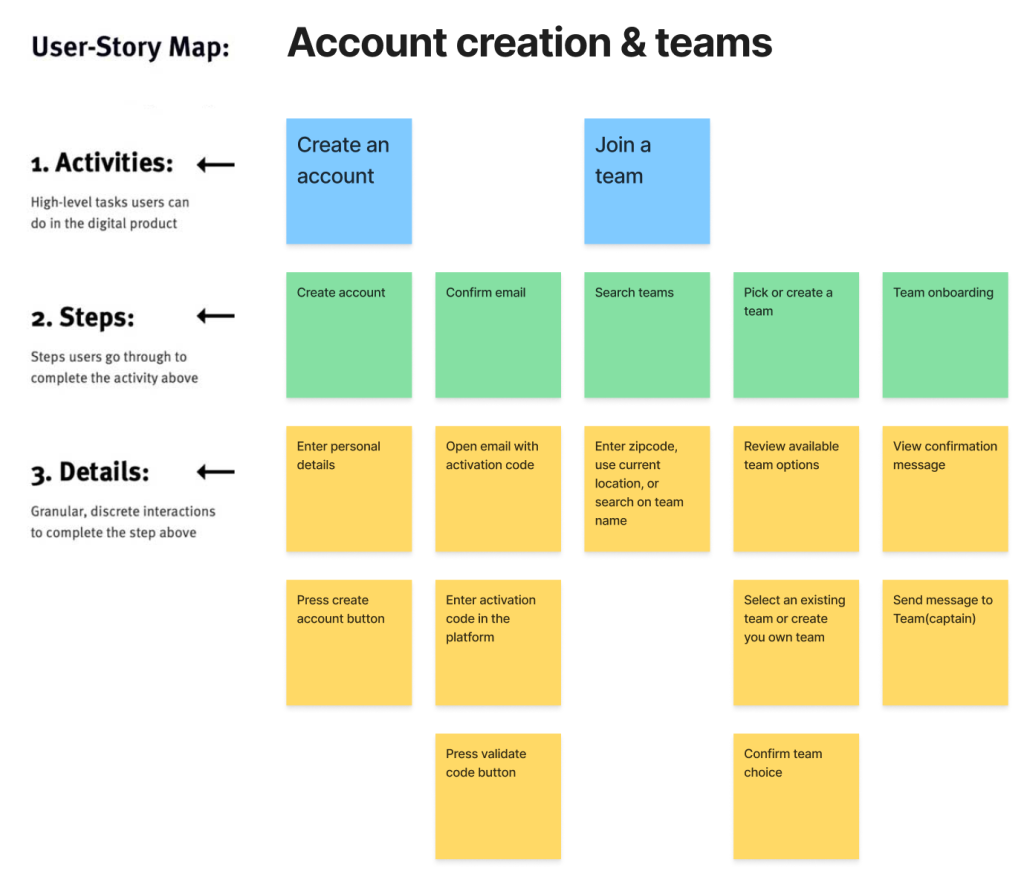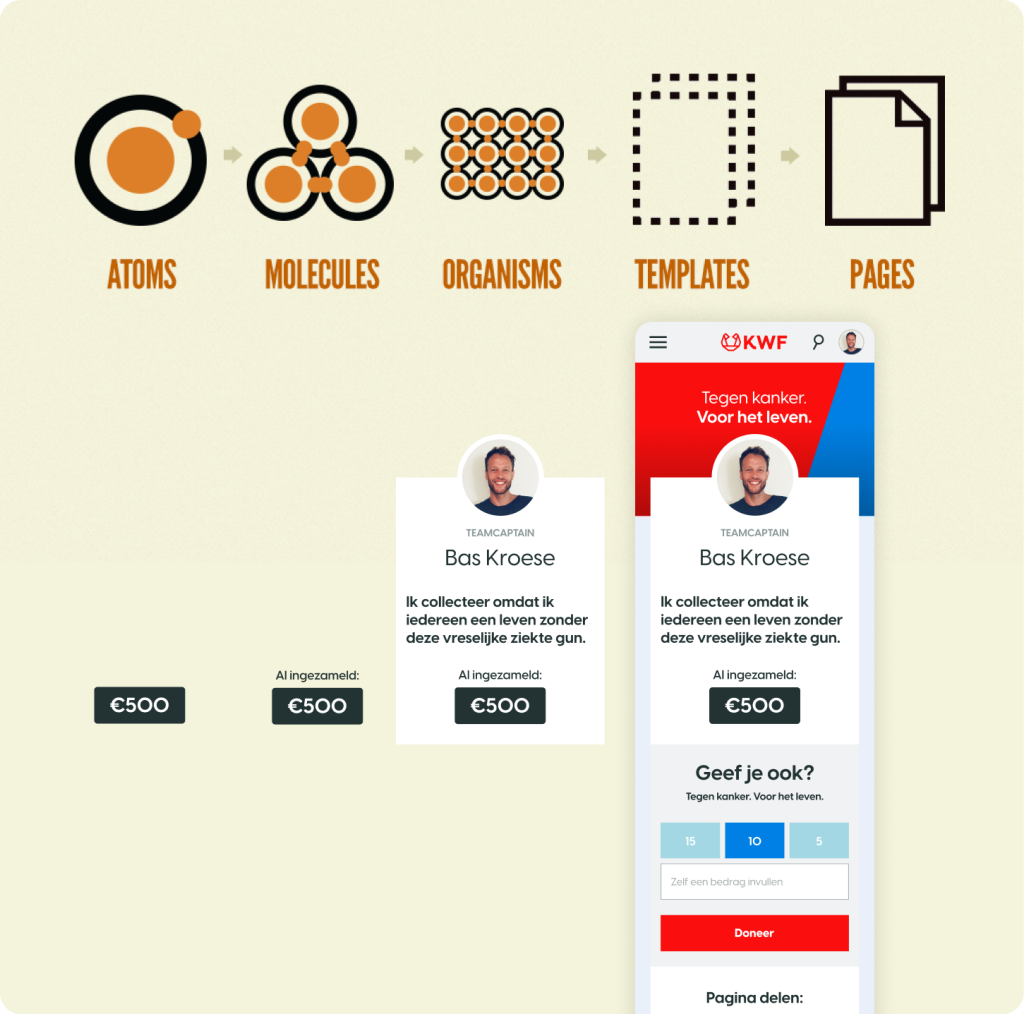KWF Collecte.
2023

The context.
KWF is a Dutch charity organisation committed to fight cancer. It is the largest charity in the Netherlands in terms of total funds raised. One of its main propositions is the yearly ‘KWF Collecte’, a week in September when across the country people take to the streets to raise money for KWF. Every year, millions of euro’s are raised by collectors.
In 2022 KWF made the decision to digitise many of the collection processes that were formerly executed manually by local organizers. The idea was that collectors would become independent of local organizers and be able to arrange everything themselves through an app on their phone.
The challenge.
The digitisation of the collection was not immediately a success. Adoption of the new app was low and it showed in the results. Besides, the digitization had caused much frustration among volunteers, causing many to quit all together.
In 2023 we needed to tackle these issues. The goal was to create a new solution that facilitates collectors to collect effortlessly while eliminating frustrations among volunteers.
With a multi-disciplinary team and an agile process we worked in a race against the clock to launch new web-app.
My role: Lead UX/UI Designer
The process.

Empathize.
KWF has been organizing the yearly collection week since 1950 and has a loyal following of volunteers. As KWF intended to digitize the collection in 2022, we knew we needed to keep a close watch on the experience of our volunteers. We applied several research methods in order to learn as much as we could.
Diary study (2022)
As the customer journey for the KWF Collecte extends over several months, and as we needed to get a better understanding of the frictions, milestones and touchpoints a volunteer experiences in this journey, we decided to set up a diary study surrounding the 2022 Collecte. We tracked volunteers in their activities by having them provided loggings of their collecte-related experiences through an online form.
We learned, among other things, that our participants were mainly engaged with the collection (1) around the moment they received communication about the app going live, and (2) in the days just before the collection week started. This may be related to disappointing (online) marketing results in the weeks leading up to the collection week – people did not seem to feel the urgency to take any action at that time.
Interviews & feedback survey (2022)
We reached out to specific target audiences by phone to inquire about their motivations. The people we spoke to included, for example, people who had participated in the KWF Collecte last year but had yet to respond this year. Coupled with a general feedback survey we send out right after the collection week in September, we gained several interesting insights, notably:
- The disappearance of the local collection organisation demotivated many respondents. They missed a point of contact for information and motivation.
- Those who had previously participated as local organisers found themselves frustrated and neglected by KWF. Someof them dropped out from the cause all together.
- People missed the ‘community feeling’. Digitization had made the collection less of a social event, which demotivated many.

Focus group (2023)
The research surrounding the 2022 Collecte showed us that there was a clear need for a local point of contact to inform and motivate people. In addition, former organisers seemed likely to quit altogether if no organisational role would be available to them.
We needed to explore options to shape a new role for the local organiser. For this purpose we set up sessions with focus groups made up of former local organizers and influencial volunteers. The main goal was to learn about their motivations and frustrations and discover what these type of users would want from the solution we were working on.
Define.
With the insights from our 2022 studies, combined with our learnings from the focus group sessions, we drafted a new role for local organisers. They would hence be named ‘teamcaptains’ and would have a role to play again in the 2023 Collecte. All the research insights combined provided us with the opportunity to more clearly define the needs and desires of our target audiences in general.
Persona’s
Bacause we had to build the patform to facilitate for collectors as well as for teamcaptains, and because we needed to take in mind serveral other variations in our population, we created personas to capture the differences in user needs and desires.
Each persona needed to indicate what this particular user group needs in order for them to (1) take the initiative to participate in the 2023 Collecte, and (2) be successful in their collection efforts.
We also included simple visual cues about their level of knowledge about the collection and their emotion towards it (new collectors generally didn’t have the feelings of frustration that the more experienced volunteers had at this point). This was relevant for our communications- and content teams to take into account.
BMAP
We also plotted insights about a person’s choice whether or not to collect in 2022 on a Bahaviour Map (BMAP). This proved to be a powerful visual tool to help us understand why someone does or does not collect. The vertical axis indicates someone’s ‘motivation’, the will to collect. The horizontal axis indicates someone’s ‘ability’, the ability to collect (available time, location, physical and mental limitations, etc.).
A low motivation and/or ability will result in someone not collecting. Only when someone’s motivation and ability are high enough (top left of the activation threshold) it makes sense to send someone a prompt (e.g. an ad on Facebook with the aim of getting someone to sign up for a collection).
Low urgency (motivation) seems to have caused many people in 2022 to be situated at the bottom of the BMAP the moment they receive an email or were shown an add (prompt) from KWF. Older collectors experienced issues using the new technologies (lower ability), causing them to start more on the left in the map.
User stories & user flows
We already had an outline of the sitemap for the basic content pages on the platform (home, about, FAQ, etc.). The most challenging part was to build up the account pages and the actual main functionalities related to raising funds. To make sure we accomodated for all main user stories, we created user-story maps.
These maps served as a blueprint for the flows we had to create in our designs.
Ideate.
The personas, BMAP, and user story maps played an important role in providing us with a framework for identifying the areas that required improvement in 2023. They guided us along the way in aligninging our new collection platform with the needs and desires of our target groups.
Guided by these frameworks, I started sketching out several concrete ideas for the platform. There were multiple design challenges to tackle. For example: catering to the desires of both the teamcaptain ánd the regular collector; and ensuring an intuitive flow for street selection.

Design system
New design elements and page templates were designed mostly from scratch. I advised that we put some extra effort in building up a design system for KWF. If done right, this could help us in the current project by making the design and development process more efficient. At the same time, it would ensure that future projects would also require less time spend on trivial designs as opposed to more complex design challenges.
Parallel to the collection project, I could now work on this design system, which I based on Brad Frost’s ‘atomic design’ methodology.
Validate.
It goes without saying that proper validation was essential in this project. In the very early stages we bounced ideas around within our own delivery team. But as soon as we had some actual wireframes and user flows worked out in Figma, we started validating with our user groups.
Prototyping in Figma
I worked out five main user flows into high-fidelity and fully interactive prototypes. These were the most essential and/or potentially challenging flows for new users, including account creation, team management and street selection.
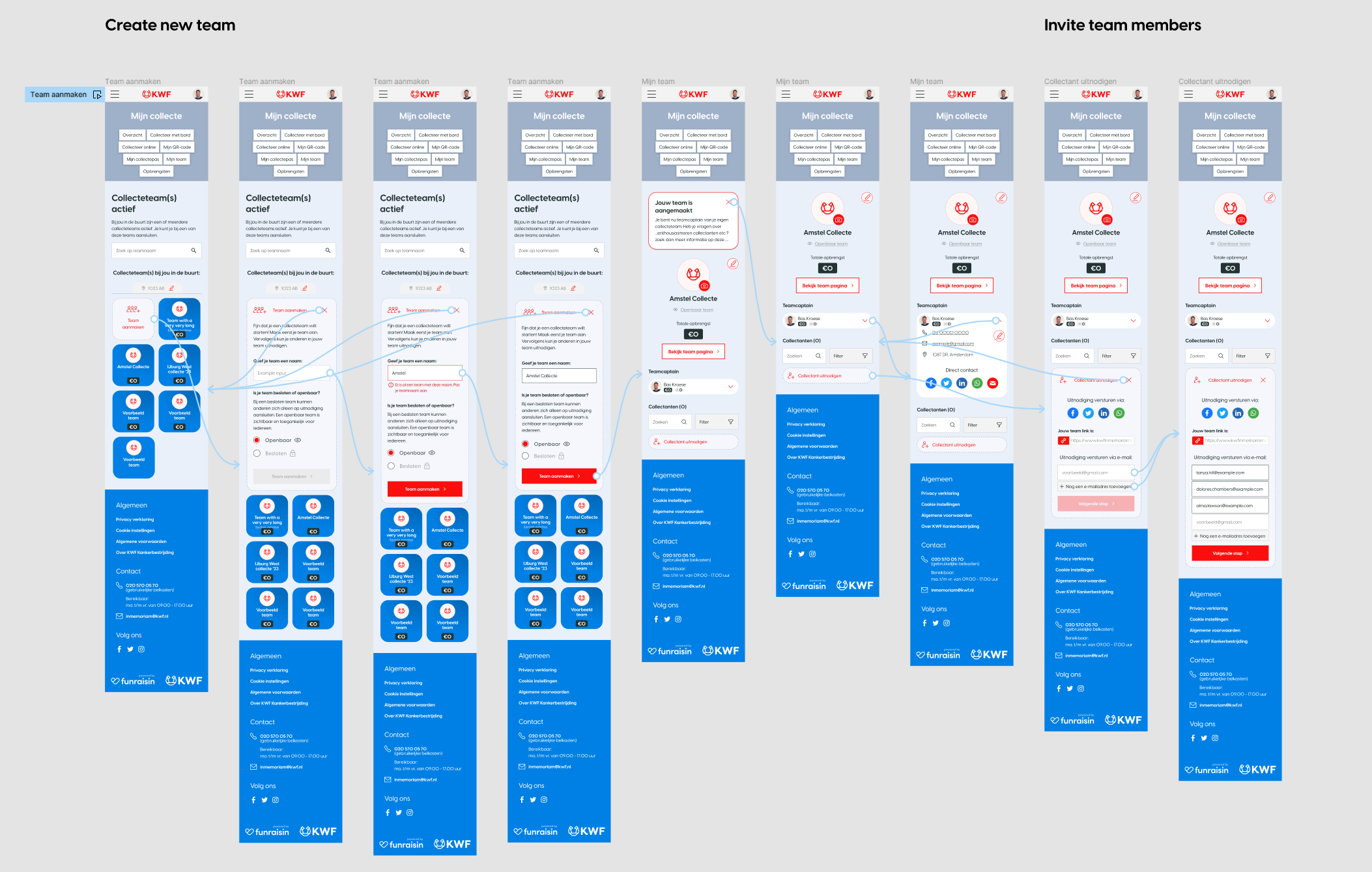
Usability testing
On multiple iterations we validated our ideas with the target audience, the teamcaptains and regular collectors. To keep the threshold low we often invited KWF colleagues to be our test participants. This turned out quite well as we had quite a varied group of colleagues, different age groups and different levels of knowledge and experience with the KWF Collecte.
We plotted our test observations onto a user journey visualization in FigJam. After each round of testing I sat together with our Product Owner to discuss what patterns we could detect in the observations and what priority we would give to different insights.
For all important insights I designed solutions to address it and created tickets in JIRA for the development team to pick it up. I was on close contact with the front-enders working on the project.

We are live.
Successful launch within 4 months. Very positive response.
We launched the platform at the beginning of June and were encouraged by the surprisingly low number of help requests that our customer service department has received in the first couple weeks. Even though the number of registrations was higher than expected.
Key results:
- Through our platform collectors had generated approximately double the revenue compared to the 2022 app.
- There was a higher average revenue per user, compared to the 2022 app.
- We saw an influx of young new users on the platform, which was one of our goals.
- We were able to take away many of our volunteers’ frustrations stemming from the 2022 digitization.
What I would do different next time
I would probably not soon pick a diary study again as a research method for a period that stretches over such a long time period. The longevity of the stody made it quite hard to really monitor the responses and we often forgot to quickly follow-up on vague or very short responses. And participants simply forgot to mention things, because after a few days it was already not at all top-of-mind for them. For a possible next time, good to consider keeping only the collection week as the study period.
Our feedback survey was quite extensive with multiple open-ended questions. The Survey was on the long side, and we saw that respondents gave fairly extensive answers in the first open-ended question and increasingly shorter answers in the open-ended questions following that. Next time, I’d consider asking fewer questions and really prioritise only one or a couple specific topics.
We could have steered our focus group sessions more on just identifying underlying needs and desires. Instead, the conversation often got bogged down in participants listing specific features they wanted to see in the product, which was not what I needed.
